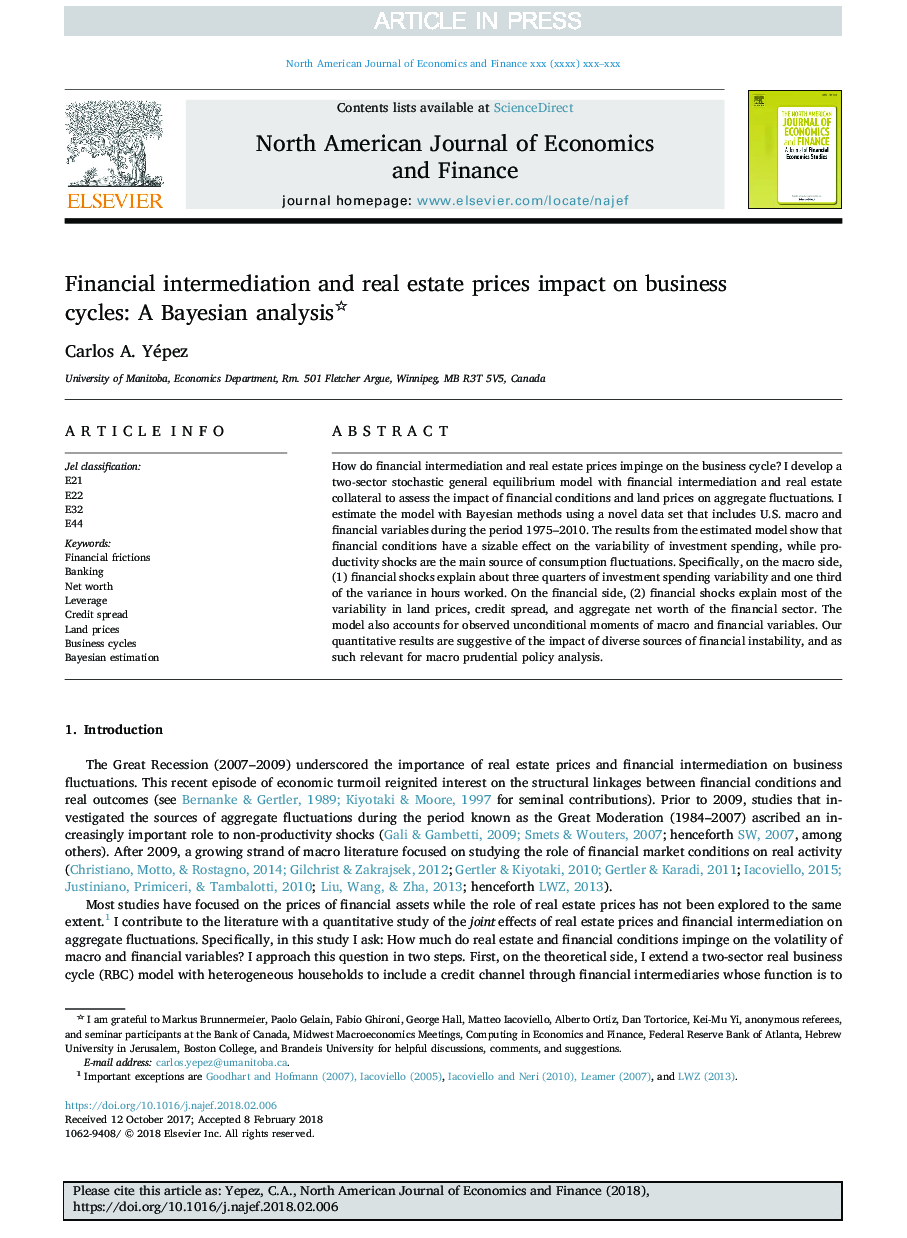| کد مقاله | کد نشریه | سال انتشار | مقاله انگلیسی | نسخه تمام متن |
|---|---|---|---|---|
| 7373740 | 1479769 | 2018 | 23 صفحه PDF | دانلود رایگان |
عنوان انگلیسی مقاله ISI
Financial intermediation and real estate prices impact on business cycles: A Bayesian analysis
ترجمه فارسی عنوان
واسطه مالی و قیمت املاک و مستغلات بر چرخه های تجاری تأثیر می گذارد: تحلیل بیزی
دانلود مقاله + سفارش ترجمه
دانلود مقاله ISI انگلیسی
رایگان برای ایرانیان
کلمات کلیدی
ترجمه چکیده
چگونه واسطه مالی و قیمت املاک و مستغلات در چرخه کسب و کار تاثیر می گذارد؟ من یک مدل تعادلی کلی تصادفی دو بخش با واسطه مالی و وثیقه املاک برای ارزیابی تأثیر شرایط مالی و قیمت زمین در نوسانات جمع آوری می کنم. من مدل را با روش های بیزی با استفاده از یک مجموعه داده جدید که شامل متغیرهای کلان و مالی ایالات متحده در طول دوره 1975-2010 است، تخمین می زنم. نتایج حاصل از مدل برآورد نشان می دهد که شرایط مالی تأثیر قابل توجهی بر متغیر هزینه های سرمایه گذاری دارد، در حالی که شوک های بهره وری منبع اصلی نوسانات مصرف می باشند. به طور خاص، در سمت چپ، (1) شوک های مالی حدود سه چهارم متغیر هزینه سرمایه گذاری و یک سوم از واریانس در ساعات کار توضیح می دهد. در بخش مالی، (2) شوکهای مالی، اغلب متغیرهای قیمت زمین، گسترش اعتبار و ارزش خالص مالی بخش مالی را توضیح می دهند. این مدل همچنین برای لحظات بدون قید و شرط از متغیرهای کلان و مالی حساب شده است. نتایج کمی ما نشان دهنده تأثیر منابع متنوع بی ثباتی مالی است و به همین ترتیب برای تجزیه و تحلیل سیاست کلان حسابرسی مورد استفاده قرار می گیرد.
موضوعات مرتبط
علوم انسانی و اجتماعی
اقتصاد، اقتصادسنجی و امور مالی
اقتصاد و اقتصادسنجی
چکیده انگلیسی
How do financial intermediation and real estate prices impinge on the business cycle? I develop a two-sector stochastic general equilibrium model with financial intermediation and real estate collateral to assess the impact of financial conditions and land prices on aggregate fluctuations. I estimate the model with Bayesian methods using a novel data set that includes U.S. macro and financial variables during the period 1975-2010. The results from the estimated model show that financial conditions have a sizable effect on the variability of investment spending, while productivity shocks are the main source of consumption fluctuations. Specifically, on the macro side, (1) financial shocks explain about three quarters of investment spending variability and one third of the variance in hours worked. On the financial side, (2) financial shocks explain most of the variability in land prices, credit spread, and aggregate net worth of the financial sector. The model also accounts for observed unconditional moments of macro and financial variables. Our quantitative results are suggestive of the impact of diverse sources of financial instability, and as such relevant for macro prudential policy analysis.
ناشر
Database: Elsevier - ScienceDirect (ساینس دایرکت)
Journal: The North American Journal of Economics and Finance - Volume 45, July 2018, Pages 138-160
Journal: The North American Journal of Economics and Finance - Volume 45, July 2018, Pages 138-160
نویسندگان
Carlos A. Yépez,
